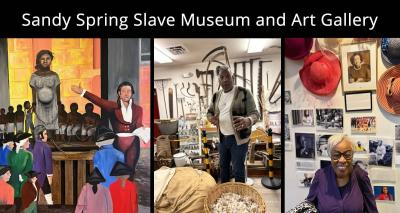The Sandy Spring Slave Museum and Art Gallery

Photos by Brenda Girton-Mitchell, Ending Racism USA
Exhibits at the Sandy Spring Slave Museum and Art Gallery:
- Left: Wall mural of a pregnant Black woman being sold at auction by and to white men.
- Center: Museum visitor with large basket of cotton on the floor and farm tools on the wall in the background.
- Right: Brenda Girton-Mitchell in front of wall of photos, including a photo of Dorothy Height, an African-American civil rights and women's rights activist, and friend and mentor to Girton-Mitchell.
Ending Racism USA has an ongoing commitment to identify educational resources and opportunities to become better informed about some of the historical contexts of racial inequity. We challenged ourselves as board and staff to explore within our communities and to connect with organizations doing work to move the United States of America forward toward becoming an anti-racist, multicultural society.
I recently toured the Sandy Spring Slave Museum and African Art Gallery, in Sandy Spring, Maryland, about 8 miles from my home. Sandy Spring was first settled in 1728 as a predominantly Quaker farming community dependent on slave labor. Between the 1770s and 1820s Quakers in Sandy Spring freed their slaves, and many of the formerly enslaved families remained in the area as wage workers.
The mission of Sandy Spring Slave Museum and African Art Gallery includes the desire to bridge the information gap and inform all ethnic groups about the advantages of cross-cultural communication and diversity, as expressed through history, the arts and the humanities. It is also available for research and community projects.
Dr. Winston Anderson founded the Sandy Spring Slave Museum & African Art Gallery in 1988. I talked with Dr. Troy Boddy, co-director of the museum, and Deborah (Smith) Buchanan, manager and board member, who shared brief stories about their lifelong connection to this community. Their commitment is fueled by the fact that they are descendants of people who were once enslaved in that geographic area.
The road that leads to the museum represents a variety of contrasts between the upscale homes, historic buildings, small retail establishments reminiscent of small country towns, a long stretch of road through a sparsely populated area and then, the unusual site of a slave cabin comes into view.
The tour features thousands of artifacts including a slaving clipper ship, African hut, historic cabin; and elements of the building of America, African civilization, slavery, hidden walls of the underground railroad, emancipation, education achievement, and the rich history of families living in Montgomery Counties kinship communities.
A sign near the exit reminded me of the critical role this museum serves in our community:
“A people without knowledge of their past history, origin and culture is like a tree without roots ...” Marcus Garvey.
Learn more about the Sandy Spring Slave Museum and African Art Gallery on their website.
